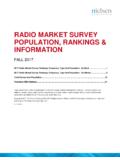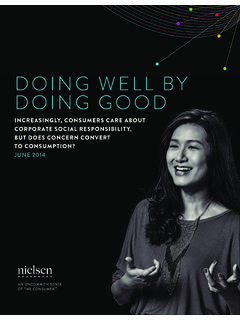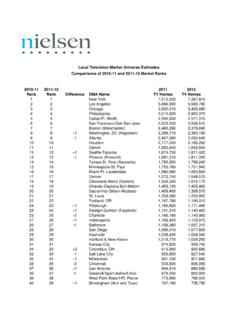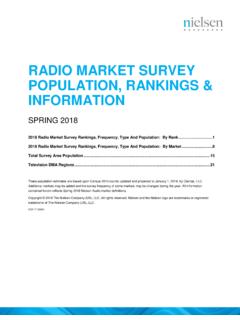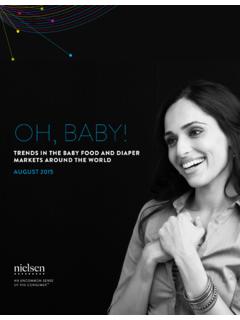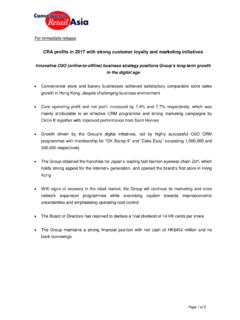Transcription of WHAT’ S IN-STORE FOR ONLINE GROCERY …
1 WHAT S IN-STORE FOR ONLINE GROCERY SHOPPING OMNICHANNEL STRATEGIES TO REACH CROSSOVER SHOPPERSJANUARY 201722017 CONNECTED COMMERCE REPORTTHE BLURRING LINES BETWEEN ON AND OFFLINE SHOPPING AROUND THE WORLD Durable and service-oriented categories continue to lead the way in self-reported ONLINE purchasing among survey respondents, but several consumable categories are growing in popularity especially personal-care and beauty categories and meal-kit and restaurant services. ONLINE and offline switching behaviors suggest that the majority of consumers who have purchased certain durable and service-related products ONLINE continue to shop ONLINE more frequently than in store for these categories. The opposite is true for fresh and packaged groceries and medicine or health-care products. For ONLINE purchasing of consumables, the most effective activation strategy among trialists (purchased ONLINE in the past but not recently) and considerers (currently don t buy ONLINE but would consider buying) is a money-back guarantee for products not matching what was ordered.
2 For fresh foods, strategies that address quality concerns top the list. For consumable categories, the most impactful way to reach consumers with messaging that influences purchase behavior is with traditional touchpoints, such as visits to a physical store. For consumer electronics and fashion purchasing decisions, the most commonly cited information sources are digital touchpoints, such as store or brand websites. Only a small percentage of consumers around the world say they re using IN-STORE and ONLINE digital technologies to aid in their shopping, but usage is 2017 The nielsen CompanyIf we had to choose a single word to describe today s consumers, connected would surely rise to the top of the list. In fact, with billion people using the internet, billion mobile-phone subscriptions and billion active Facebook users,1 connected might not even adequately describe the current marketplace.
3 Increasingly, everything and everyone is moving ONLINE , resulting in the breaking of old habits and establishment of new ones. Indeed, digital has disrupted a whole host of interactions, including the way we watch video content and the ways we communicate with friends and way we shop is no exception. Digital retailing gives consumers more ways to shop and more access to products and services than ever before. It s clear that consumers are embracing the freedom of shopping whenever and wherever they please, as ONLINE sales are capturing a double-digit share of retail dollars in some markets. In China the world s largest e-commerce market ONLINE retail sales accounted for of the total retail purchases in 2015; in South Korea, it was In Great Britain, ONLINE accounted for an average of of all retail spending through the first 10 months of 2016, and in the , e-commerce represented an average of total retail sales through the first three quarters of 2016,3 a rate that nielsen projects will grow at a compound annual growth rate (CAGR) of through these measures show more sales going ONLINE , the actual consumer behavior is a little more complicated, as the lines between ONLINE and offline channels continue to blur.
4 Traditional brick-and-mortar retailers are expanding their digital presence, while pure-play retailers are opening physical stores . The notion of being connected is taking on new meaning: Retailers are implementing innovative digital technologies that are transforming the shopping experience, in order to become more relevant to consumers lifestyles and shopping occasions. Thinking in terms of bricks versus clicks is outdated; bricks-and-clicks is the current and future retail subscriber data from International Telecommunication Union (2016). Facebook user data from Facebook (September 2016).2 National Bureau of Statistics of China; Statistics Office for National Statistics; Census Bureau, Department of VERSUS CLICKS IS OUTDATED; BRICKS-AND-CLICKS IS THE CURRENT AND FUTURE RETAIL CONNECTED COMMERCE REPORTABOUT THE STUDYN ielsen Global E-Commerce spans over 20 countries around the world.
5 Measurement may rely on direct from retailer data (ePOS), data collected via nielsen s Consumer Panels, other licensed data, or a combination of the foregoing. Retail sales data for China and France is for the two years beginning September 2014 and ending in August findings are based on more than 30,000 respondents with ONLINE access in 63 countries. While an ONLINE survey methodology allows for tremendous scale and global reach, it provides a perspective on the habits of only existing internet users, not total populations. In developing markets where ONLINE penetration is still growing, respondents may be younger and more affluent than the general population of that country. In addition, survey responses are based on claimed behavior, rather than actual metered data. Cultural differences in reporting sentiment are likely factors in the outlook across countries.
6 The reported results do not attempt to control or correct for these differences; therefore, caution should be exercised when comparing across countries and regions, particularly across regional boundaries. As shoppers increasingly move seamlessly between offline and ONLINE channels, purchase habits are changing. Simply adapting to keep pace is no longer sufficient, said Kristen Cocco, vice president, global e-commerce measurement, nielsen . Savvy marketers know that using digital tools in new and innovative ways to engage with shoppers and influence shopping decisions must be a part of their growth plan for the future. To create maximum ROI in an omni-channel environment, winning brands and retailers must know their shoppers their demands and how and what they re buying ONLINE and IN-STORE and then leverage the specific touchpoints that will maximize their shopping experience.
7 The nielsen Global Connected Commerce Survey polled ONLINE respondents in 63 countries to understand the underlying factors that influence the evolving digital path to purchase. We examine the pain points and barriers associated with buying fresh and other consumable products ONLINE , and we uncover the activation strategies that can help overcome these obstacles. We also provide a view into the digital technologies consumers are using in stores today and the ones that hold promise for tomorrow. Finally, we outline the biggest disruptive trends that will fuel the growth of connected commerce in the years to 2017 The nielsen CompanyTHE CONNECTED CATEGORY STORY: DURABLES DOMINATE, BUT CONSUMABLES GAIN TRACTIONG lobally, more than 93% of respondents in nielsen s ONLINE Connected Commerce Survey say they ve ever shopped ONLINE not surprising, given that the findings are based on internet-connected consumers.
8 But the significance of this number is noteworthy. Not only does it speak to how pervasive ONLINE shopping is among the growing ONLINE population, but also provides an insightful view into purchase behaviors that will only accelerate as internet penetration continues to grow. And when it comes to buying ONLINE , category dynamics are fluid and and service-oriented categories continue to lead the way in self-reported ONLINE purchasing, as expected. These categories formed the baseline of entry for e-commerce, and their popularity continues to expand. More than half of global respondents in the ONLINE study say they ve purchased fashion products (58%) or travel products or services (55%) ONLINE , and half say they ve purchased books, music or categories, in contrast, have been slower to gain popularity among ONLINE shoppers, but that is changing especially for categories that are filling particular need states exceptionally well.
9 In fact, nearly four in 10 global respondents (38%) say they ve purchased personal-care and beauty products ONLINE , and about one-fourth say they ve ordered meal-kit or restaurant delivery services (27%) or packaged GROCERY food (24%) CONNECTED COMMERCE REPORTMeal-kit services are an interesting example of a new retail model that has taken the by storm in the past few years, with companies catering to just about every food preference, from vegan to gluten free. These services have gained traction for several reasons. Ingredients are delivered straight to consumers doors with cooking instructions, eliminating the drudgery of having to plan meals and go to the store to get the required ingredients. In addition, they have wide appeal, offering exotic flavors and a more convenient solution to traditional cooking for busy food enthusiasts, while providing guidance for less confident cooks.
10 Meal-kit delivery services meet consumers needs for convenience and customization, allowing time-crunched consumers to choose from myriad options that best fit their lifestyles, said Cocco. They also tap into the trend toward more healthful eating by offering fresh, high-quality ingredients, which is creating a powerful recipe for growth. Many opportunities exist for retailers to leverage their ability to grab the IN-STORE purchase and delivery-to-home option by offering meal kits in addition to expanding the prepared-meal space to better compete with restaurant delivery services. While direct-to-consumer meal-kit companies tend to focus on organic or locally sourced products, as more retailers expand their meal-kit offerings, large manufacturers have an opportunity to partner and incorporate their specific ingredients. When it comes to fresh groceries, images simply can t replace the physical look, feel and smell of these products.




